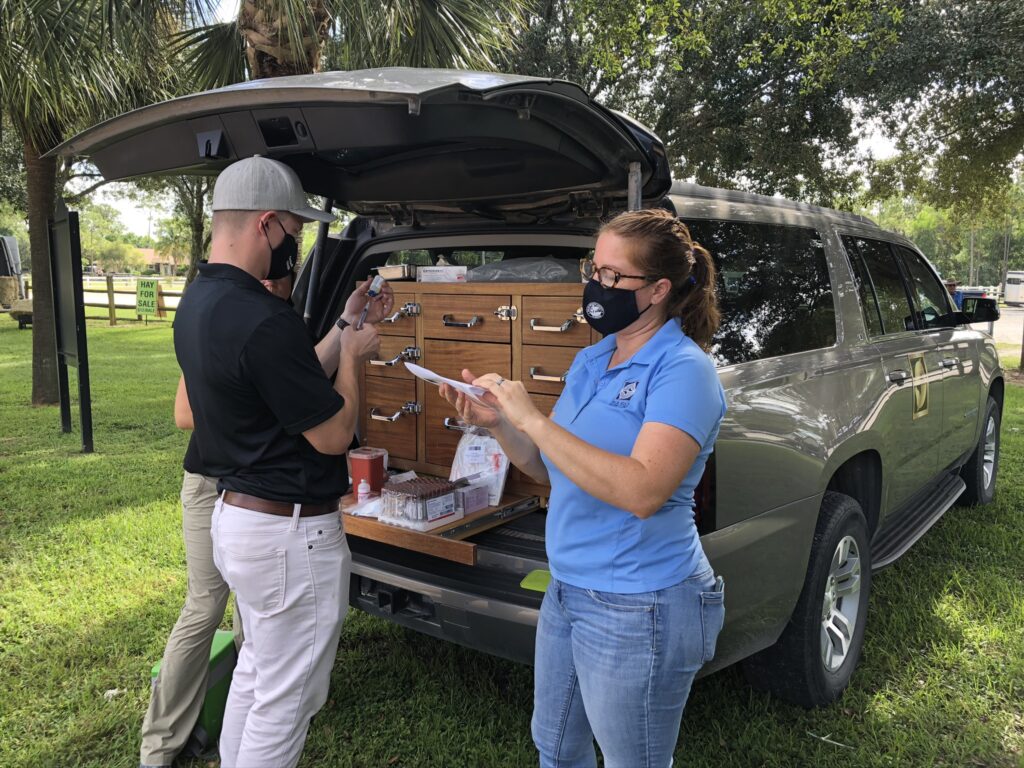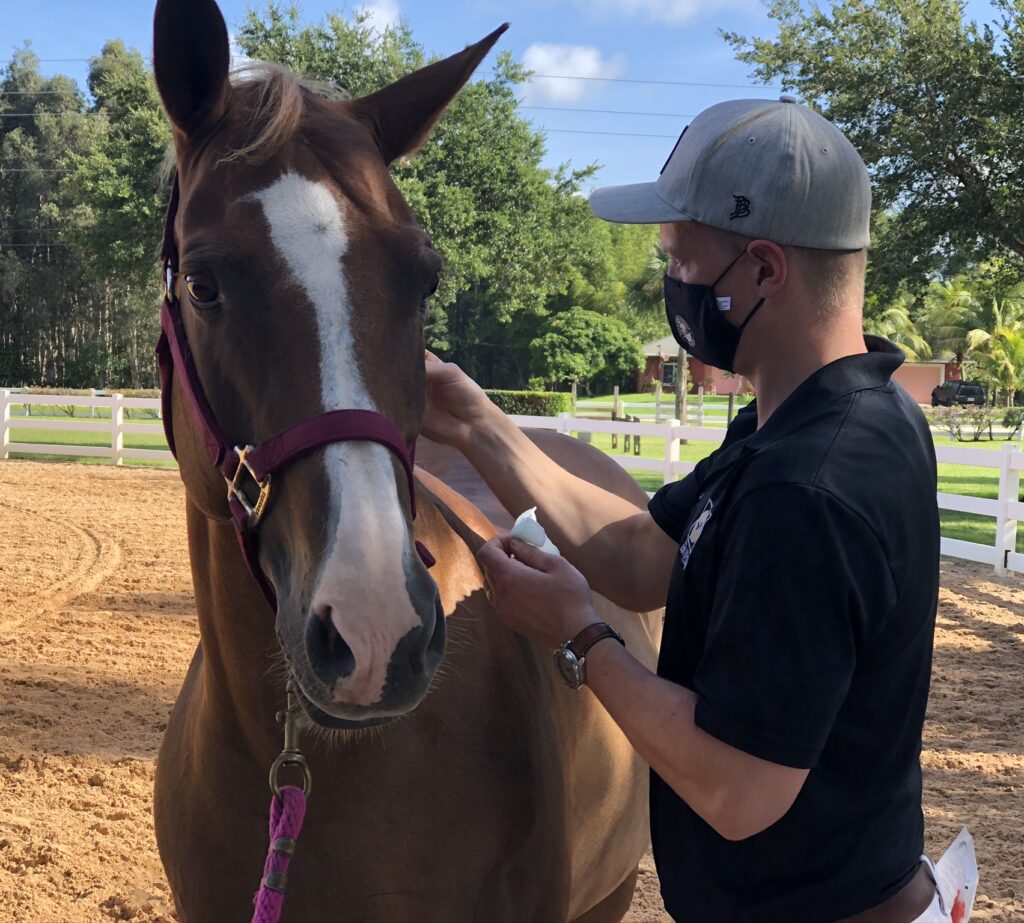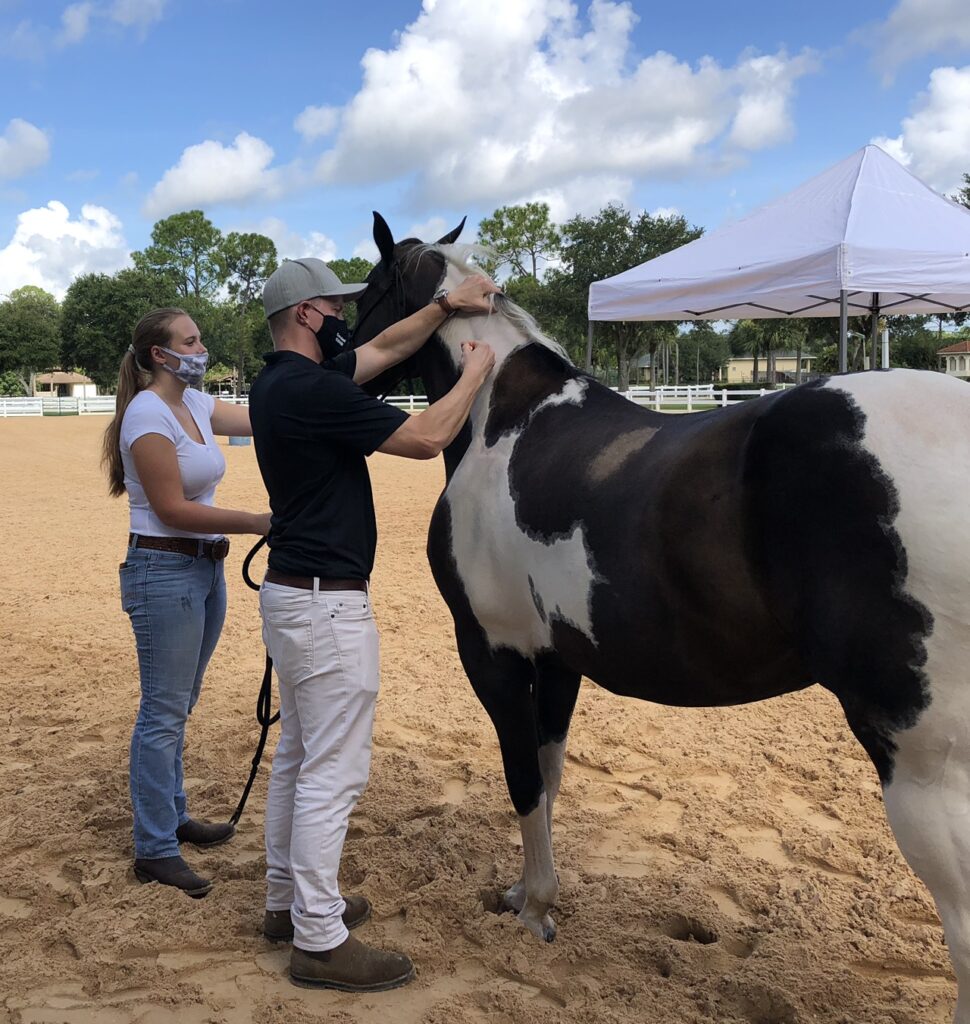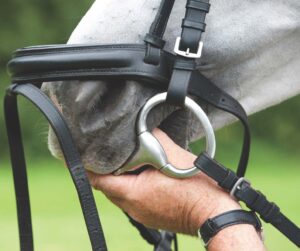Year: 2020
Palm Beach Equine Clinic provided veterinary services for horse owners as part of a new clinic series by the Acreage Landowners’ Association, Western Equestrian Shows and Trails, and the Indian Trail Improvement District.
Loxahatchee, FL (August 18, 2020) – Kicking off a first-of-its-kind clinic series for horse owners of western Palm Beach County, several Acreage groups enlisted the veterinary team of Palm Beach Equine Clinic (PBEC) to provide hurricane preparedness expertise. The clinic, held on August 15, 2020, at Nicole Hornstein Equestrian Park in Loxahatchee, Florida, was originally scheduled for the first of the month, but was postponed in true Florida fashion due to Hurricane Isaias.
The Equine Hurricane Preparedness Clinic garnered a couple dozen attendees, masked up with their horses in tow. Kim Emmons, Western Equestrian Shows and Trails (WEST) Clinic Director and certified equine veterinary technician, is the driving force behind the event series.
“I’ve lived in and have been active in our local equestrian community for over 20 years,” said Emmons, who led the discussion on best practices for horse owners during hurricane season.
“The goal of this clinic series is to educate our local equestrian community and provide opportunities for horse owners of all ages and disciplines to become better, more well-rounded horsemen.”
Kim Emmons
Through attending equestrian events, teaching at camps, and her experience as a veterinary technician, Emmons has met many horse owners who lack the correct skills and knowledge on basic horse health and care. “I have always found it really rewarding to share my knowledge by teaching people the proper, practical skills for caring for their horses. Things such as correct leg bandaging, taking their horse’s vitals, listening to gut sounds, and teaching people on when they need to call a veterinarian are all essential for a horse owner to know. I used to teach an equine healthcare camp, and I am so proud to see those young campers grow into the smart, well-rounded equestrians they are today.”
The clinic series is free to attend, with fees for trailering in and offered membership packages, and will be based at Nicole Hornstein Equestrian Park for the foreseeable future.
PBEC provided special reduced rates on equine vaccinations, Coggins (Equine Infectious Anemia) testing, and microchipping services performed by Dr. Janet Greenfield-Davis and Dr. Charley McColough.
“We understand that, especially now in these pandemic times, many people are struggling to cover their horse’s expenses,” said PBEC veterinarian Dr. Greenfield-Davis. “We are happy to be here for the community by providing these essential services at more affordable prices and in a more convenient location for the Acreage horsemen.”
WEST, a new subcommittee of the Acreage Landowners’ Association (ALA), is led by fellow longtime Acreage resident Dixie Thiery.
“All of our efforts are focused on promoting and protecting the wonderful equestrian lifestyle we are lucky to enjoy here,” said Thiery. “We hope that WEST and this clinic series will help strengthen our community by giving people an easy, convenient way to learn and meet their neighboring equestrians. We are also very fortunate to be supported by the Indian Trail Improvement District, which is responsible for this park, and we are working with them to update our local trail system maps and better plan for equestrian-safe roadways and developments.”
ALA, WEST, ITID and PBEC plan to work together in the future by collaborating to bring horse shows, tack sales, exhibitions, and other educational events for equestrians to the area. The association’s next clinic is planned for September 19 and will focus on basic equine first aid.
In January of 2020, Palm Beach Equine Clinic veterinarian and board-certified surgeon Dr. Weston Davis performed colic surgery on Bull Run Jumpers Prince of Peace. Piloted by Kristen VanderVeen, “Prince” has proven he has fully recovered and is back in peak condition in August of 2020 by claiming the top spot in the $36,600 Traverse City Speed Classic CSI3* at the Great Lakes Equestrian Festival.
Congratulations to this fantastic pair from the entire PBEC Team!
Palm Beach Equine Clinic is incredibly proud to have been entrusted with the health and well-being of Prince and numerous other colic surgery patients who have gone on to make full recoveries, returning to training and competing as they were before the colic.
Each colic surgery case has its own specifics, and during Prince’s recovery, he particularly benefited from strategic veterinary use of the regenerative therapy RenoVo to strengthen the abdominal wall at the surgical incision. Dr. Davis adjusted Prince’s recovery plan as he returned to more intense exercise by using this regenerative medicine to provide some cellular scaffolding and growth factors to encourage proper tissue repair of the abdominal wall.
For more information on colic surgery, regenerative therapies, or to talk to Dr. Davis about your own horse’s needs, please call 561-793-1599 or fill out the form below.
Get in Touch with Palm Beach Equine Clinic
From The Pharmacy: New Xiang Ru San
Option for Anhidrosis

Palm Beach Equine Clinic is proud to offer a wide range of treatments and therapies, including select Chinese herbal medicines. New Xiang Ru San is one such herbal medicine that can be used to treat horses suffering from anhidrosis, or the inability to sweat normally. Anhidrosis can be a common challenge, particularly in hot, humid climates. New Xiang Ru powder has proven to be a clinically effective aid for non-sweaters as it promotes heat and fluid disbursement through healthy sweating. New Xiang Ru San is a blend of the Chinese herbs Bian Dou (hyacinth bean), Xiang Ru (mosla), Hou Po (magnolia bark), Lian Qiao (forsythia) and Jin Yin Hua (honeysuckle flower).
Chinese herbal medicine is a relatively new treatment among equine veterinarians in the western world, but the philosophy of using herbals in healing has existed for thousands of years as part of Traditional Chinese Veterinary Medicine (TCVM). An adaptation of all-natural methods used to treat humans, herbal medicine for animals utilizes ancient Chinese formulas aimed at understanding and treating the underlying causes of a particular disease or illness in order to help the body heal itself, rather than only treating the presented symptoms.
Talk to your PBEC veterinarian about options for treating anhidrosis or call 561-793-1599 to set up an appointment.
Appointment Request
Please fill out this form and our staff will contact you to confirm an appointment.
A Healthy Mouth is a Supple Mouth
Healthcare Reminder: Equine Dentistry
The general goals of equine dentistry may appear straight-forward but include a complex system of evaluations that in turn affect the entire body and well-being of a horse. At its core, equine dentistry encompasses the objectives of maintaining even tooth wear, treating infection or disease, allowing for proper digestion, and promoting longevity. Dr. Tyler Davis of Palm Beach Equine Clinic says that routine and thorough dental exams can help prevent many issues from ever becoming problems.
Why do horses require dental care?
Horses grind their food into a finely masticated bolus before swallowing. The combination of a horse’s upper jaw being larger than the lower jaw, and the fact that a horse chews by moving their jaws from side to side results in uneven wear of the teeth. This uneven wear may cause sharp edges to form, which hinder efficient chewing and may ulcerate or tear the cheeks and tongue. Uneven wear can also cause the horse to swallow food that isn’t properly chewed and can lead to more daunting problems such as colic.
No horse is exempt from needing their teeth cared for by a veterinarian. For sport horses, however, dental care becomes even more crucial. Much of the connection between horse and rider comes by way of the horse’s mouth, and depending on the discipline, the horse may always have pressure in their mouth. If there are problems or discomfort within the mouth, it can become evident in the horse’s performance and disposition under saddle.
According to Dr. Davis, having a horse’s teeth in perfect shape allows one to immediately rule out dental issues when trying to troubleshoot a performance problem. A “sound mouth” also allows the best condition for supple, soft, and accurate connections between horse and rider through the bridle.
What is floating?
On a basic level, most horses require a routine float. Floating is the term for rasping or filing a horse’s teeth to ensure an even, properly aligned bite plane. While floating is the physical process, the scope of equine dentistry is much broader and examines the horse’s overall health as influenced by the mouth.
“A proper dental exam using a lightweight speculum, a very good light source, and a dental mirror allows me to see any possible problems and prevent those problems from becoming painful and affecting a horse’s performance and overall health,” said Dr. Davis.
How often should you have a veterinarian perform a routine dental exam on your horse?
Dr. Davis recommends an exam every 12 months at a minimum. For many sport horses, the demands of their competition schedule may require bi-yearly exams to prevent any problems that could sideline them from training or events. Lastly, any horse with a history of dental problems may require exams every three to four months. Without routine dental exams by a veterinarian, uneven wear can escalate to a serious health problem.
The most common signs of dental discomfort in horses include:
- head-tilting and tossing
- difficulty chewing
- bit-chewing and tongue lolling
- tail-wringing, bucking and other behavioral issues
- drooling and bad breath
- (sometimes) weight loss and spillage of grain
Technological Advances
While it is the owner’s responsibility to develop a diligent care routine, the veterinary community has done its part by continuously improving evaluation and diagnostic technology. Advances in instruments, such as the speculum and imaging technologies, allow veterinarians to better understand and examine the equine mouth. In turn, they are able to diagnose and treat dental problems more effectively.
Equine dental health is far more involved than simply evaluation the outward appearance of the teeth. While trained eyes can see external problems, and educated hands can feel for abnormalities, assessing internal issues can be done through diagnostic imaging. Improved imaging technology has greatly expanded Dr. Davis’ ability to find and analyze unseen problems in the mouth.

Portable imaging technology, such as digital radiography (x-rays) allows him to conveniently understand dental pathology better for his patients in the field. While Standing Computed Tomography (CT) allows Dr. Davis to capture a comprehensive, multiplanar profile of all the structures within the horse’s head, with the horse only lightly sedated.
“Having these advanced imaging modalities available for my patients allows us to thoroughly identify an issue and then intervene as early as possible to treat the issue, relieve discomfort, or prevent tooth loss,” commented Dr. Davis.
Contact your veterinarian at Palm Beach Equine Clinic for more information on equine dentistry, or to schedule a dental exam, at 561-793-1599.
Get in Touch with Palm Beach Equine Clinic
Contact us by filling out this form.
Bella Ciao: Back Out Front

Racehorse Bella Ciao Undergoes Surgical Repair
Trainers Alessandro and Antonio Sano reviewed a daunting x-ray on the morning of April 19, 2019. Their three-year-old Thoroughbred filly Bella Ciao, owned by Cairoli Racing Stable and Magic Stables LLC, had just finished a breeze in 49 seconds flat when she suffered a fracture in her right front leg.
She exited the track at Gulfstream Park West, her home racecourse in Miami Gardens, FL, with her racing fate hanging in the balance.
“She is a tough filly with a lot of heart, and she walked herself back to the barn where we had x-rays taken,” said Alessandro, who met with the track veterinarian right away to identify the problem. “When we saw it, we were nervous that she was headed to the breeding shed, and her career was over.”
Alessandro and his father, however, were not willing to give up on their special filly. They entrust Palm Beach Equine Clinic’s board-certified surgeon, Dr. Robert Brusie, with care of their entire string of racehorses, and quickly decided to send the x-rays for his review. Dr. Brusie quickly identified a condylar fracture and advised a surgical repair. Immediately after her diagnosis was confirmed, Bella Ciao made her way to the Hospital at Palm Beach Equine Clinic.
Identifying a Condylar Fracture
A condylar fracture is a repetitive strain injury that results in a fracture to the cannon bone above the fetlock. The fracture is a result of excessive strain and weight carried over the cannon bone during high-speed exercise. It emerges from the fetlock joint running laterally up or medially out the side of the cannon bone, essentially breaking off a corner of the bone.
“A condylar fracture is a disease of speed,” said Dr. Brusie. “A condylar fracture was once considered the death of racehorses. As time and science progressed, it came to be considered merely career-ending. Currently, veterinary medical sciences are so advanced that we have had great success with condylar fracture patients returning to full work.
“Luckily, with today’s advanced rehabilitation services, time, and help from mother nature, many horses can come back from an injury like this. My prognosis for Bella Ciao after surgery was very good,” said Dr. Brusie.
Dr. Brusie performed Bella Ciao’s surgery and inserted five screws to repair the fracture.
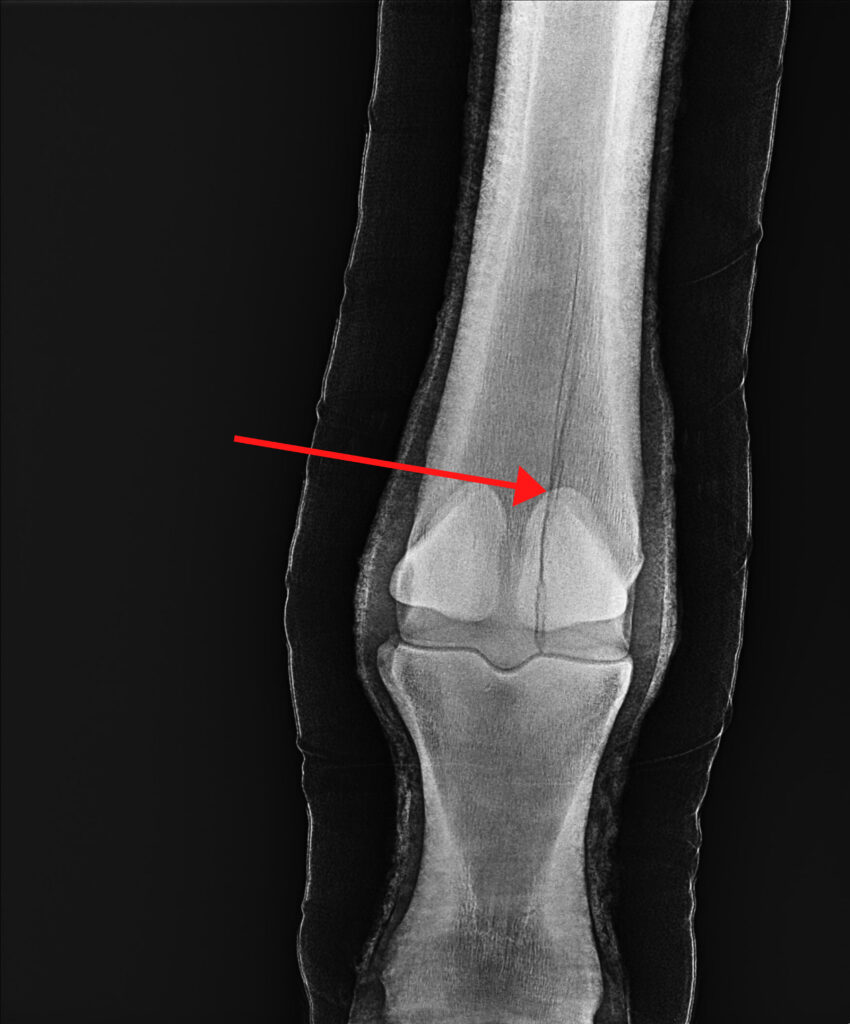

From left to right: Digital radiographs show the condylar fracture to the right front leg, and the five screws that completed the surgery.
“He does an excellent job with all of our horses. We wanted to give it a shot for Bella Ciao, and it paid off,” said Alessandro. He and his father, Antonio, have worked with Dr. Brusie on many horses, including a past Kentucky Derby runner and horses winning in excess of million-dollar purses. “He told us that she would be back to the track, so we followed his instructions perfectly.”
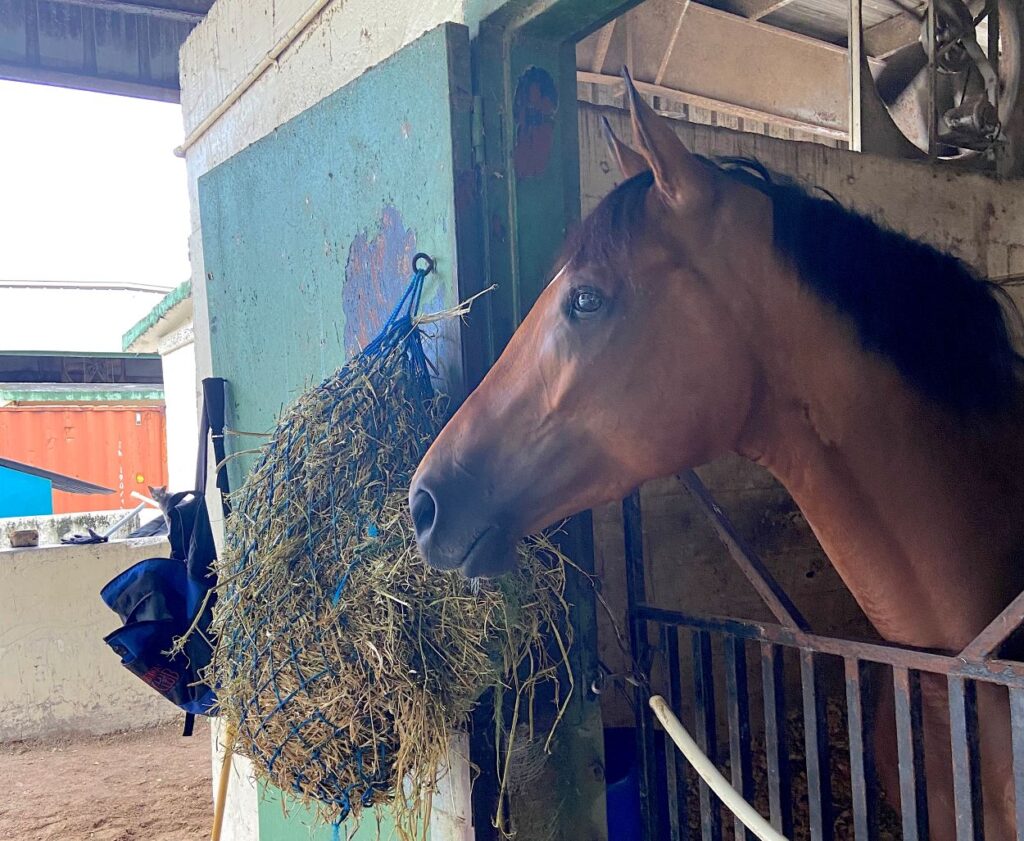
Back On Track
Dr. Brusie prescribed stall rest and hand walking for the first several months of Bella Ciao’s recovery. She slowly began jogging, and then breezing.
On October 27, 2019, she returned to the track in a $45,000 Allowance race. With Leonel Reyes up in the irons, Bella Ciao made her comeback in storybook fashion by winning that race and coming out fit, sound, and healthy. Now a four-year-old, Bella Ciao won again on April 30, 2020, and most recently placed third in a $60,000 race on June 27.
“While treatable, a condylar fracture is not an easy injury to come back from, but Dr. Brusie is one of the best surgeons in the country, and we trusted him,” said Alessandro, who has been working with Dr. Brusie since he and his father moved their business from Venezuela to the U.S. in 2010. “She recovered brilliantly, and we could not be happier with how she is going now. She is a special filly, and we are thrilled that we took this chance on her.”
A Look at Palm Beach Equine Clinic’s Advanced Imaging Technology
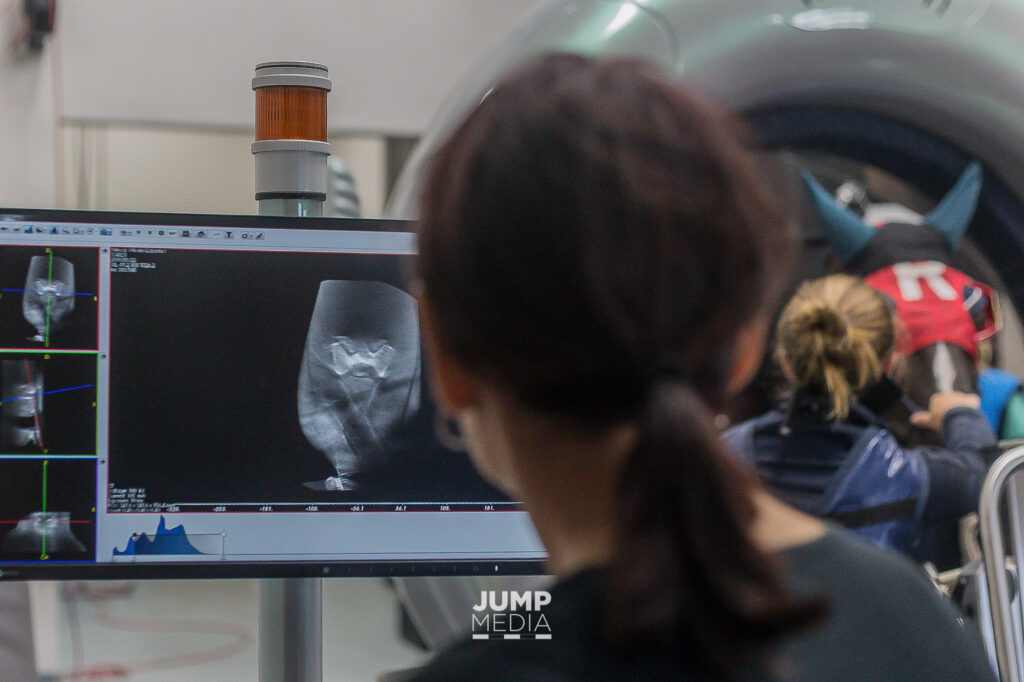
Photo by Jump Media
Palm Beach Equine Clinic takes pride in being a world-class facility for the diagnosis, treatment, and recovery of some of the industry’s most valued sport horses, as well as backyard companions. A vital area of the Equine Hospital that helps veterinarians to diagnose subtle or acute lameness is the Advanced Imaging Department.
Producing thousands of scans a year across all modalities, the Palm Beach Equine Clinic Imaging Department offers an on-staff, board-certified radiologist, and equipment that elevates the effectiveness of lameness diagnostics. Lameness is no longer a guessing game as PBEC veterinarians have an arsenal of imaging technologies to capture inside the horse.
Tour the PBEC Imaging Department:

Nuclear Scintigraphy (Bone Scan)
Nuclear scintigraphy begins with the injection of a radioactive isotope called Technetium 99 that is bound to a phosphate analogue. The isotope – phosphate molecule attaches to the mineral matrix of the bone in areas where bone is active. A gamma camera is then used to capture images of the skeletal anatomy. Points that “light up” on the image indicate increased metabolic activity as a possible site of injury.

Standing Magnetic Resonance Imaging (MRI)
The standing MRI produces highly detailed, cross-sectional images of bone and soft tissue in multiple different planes to fully image a desired region. The standing MRI requires sedation (not anesthesia) and is best used to further define a specific area that has already been pinpointed as the origin of lameness.
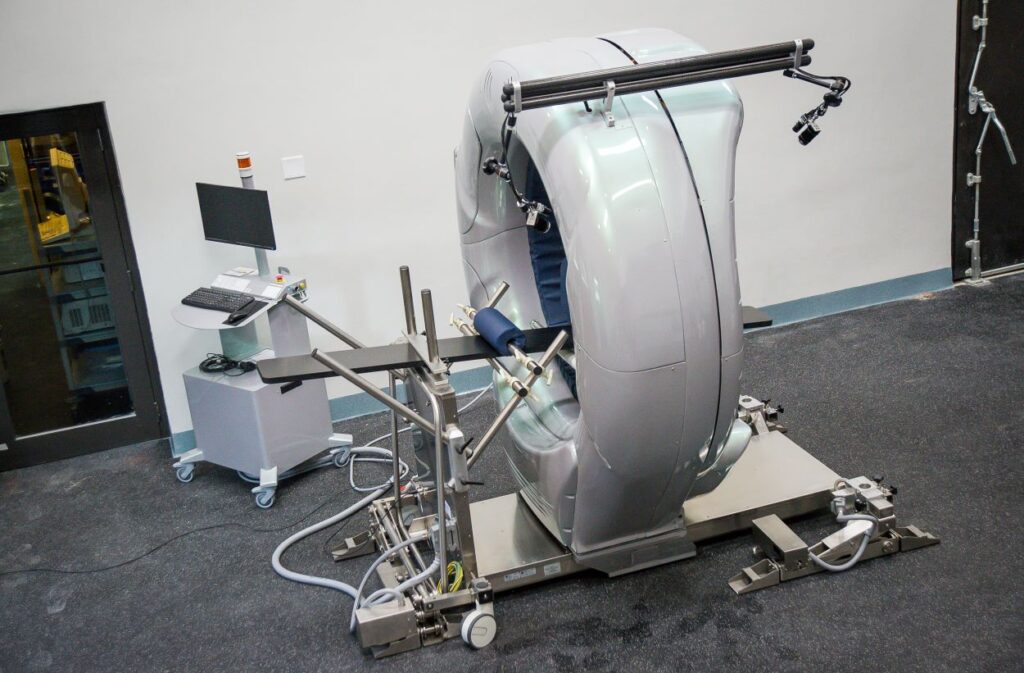
Computed Tomography (CT)
Similar to its use in humans, CT allows veterinarians the unique opportunity to conveniently explore areas of a horse’s body that were previously inaccessible. The machine produces 360 degree images of a horse’s neck, spine, and head and can be conducted while a horse is standing and under only light sedation.
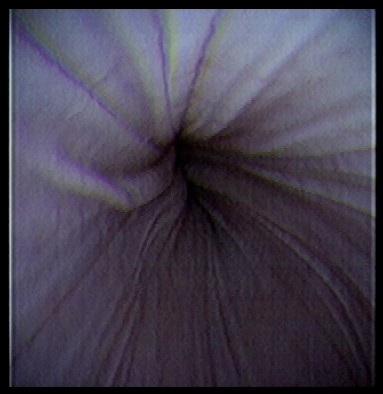
Endoscopy
An endoscope is an instrument that allows veterinarians to look inside the body by being inserted through a natural opening or incision. A tiny camera on the instrument allows an in-depth view of internal structures such as the upper and lower respiratory track, gastrointestinal and urinary tracts, as well as the cervix and uterus of mares.

Digital Radiography
Used routinely, radiographs are traditional x-rays that are made available within seconds for digital viewing and evaluation.
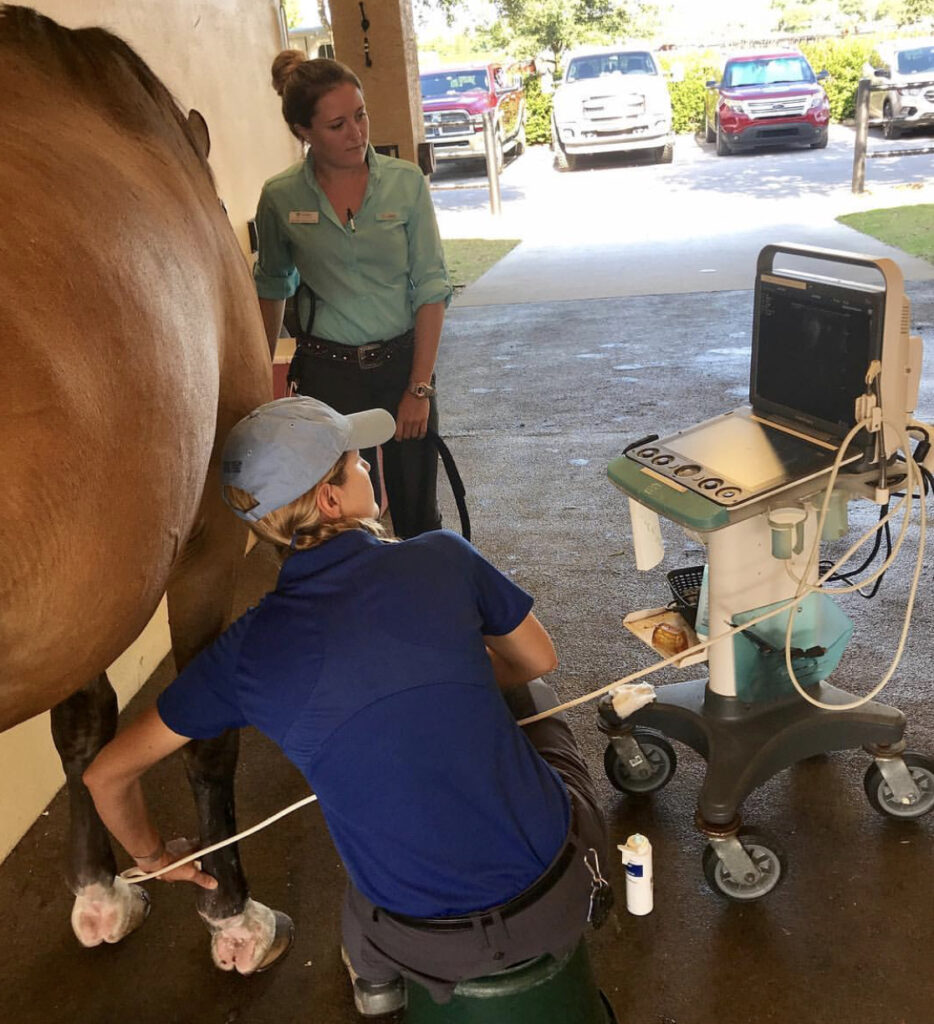
Ultrasonography
An ultrasound machine generates high-frequency sound waves, which echo an image back to the machine where bone appears white, fluid appears black, and all other structures are on a grayscale. An ultrasound is non-invasive, usually does not require sedation, does not use radiation or require injecting radioactive isotopes, and provides real-time images.
“These tools can give a definitive diagnosis, and that saves time and money in the long run,” said board-certified radiologist Dr. Sarah Puchalski. “For example, if a horse goes lame and it gets seen and treated empirically, which is a diagnosis based on likely problems through common diagnostic procedures, it either stays sound or it becomes lame again or even non-functional in three to six months. This method sets back the commencement of the appropriate therapy.
“What these modalities do is allow the horse to be treated early and correctly,” continued Dr. Puchalski. “Otherwise, you may not be treating the correct issue, and the horse could end up lame again very soon.”
Brittany Riddle, manager of PBEC’s Nuclear Scintigraphy Department, is fascinated by the structure of the horse’s body and helps to produce hundreds of bone scans per year.
“I’ve always had a strong interest in the anatomy of horses,” said Riddle, who spends her workday keeping patients comfortable and calm while operating a gamma ray camera housed in its own suite at Palm Beach Equine Clinic. “The horses are under light sedation for standing scans and these usually take from one to four hours depending on the type of scan. Usually during the winter competition season, we have anywhere from two to three horses being scanned daily.
“The variety of patients we treat is always interesting,” continued Riddle. “We see patients from all aspects of the industry. From racehorses to polo ponies, western performance, dressage, top show jumpers and hunters.”
According to Palm Beach Equine Clinic President Dr. Scott Swerdlin, having the latest in diagnostic capabilities drives the success of the Clinic.
“Many years ago, we committed to establishing Palm Beach Equine Clinic as an all-inclusive hospital and making it the most advanced referral center in the country,” said Dr. Swerdlin. “By investing in the very best personnel and equipment, we are able to provide the very best care we can for our patients.”
Meet The Team: Dr. Laura Hutton
Dr. Laura Hutton grew up immersed in equestrian culture in Enniskillen, Northern Ireland. She can’t recall a time when she wasn’t dreamily gazing at horses in a field or fantasizing about the day when she would pilot a show jumper in the competition ring. She knew at an early age that she wanted to be an equine veterinarian, and she stuck to that goal.
When not caring for horses, Dr. Hutton can be spotted competing in the adult jumper ranks on her jet-black Dutch Warmblood mare, Brimara. She even competes against one of her mentors, Dr. Jorge Gomez.
Dr. Hutton is currently spending her summer in New York with ambitions to compete at HITS Saugerties and Great Lakes Equestrian Festival in Traverse City, MI.
What brought you to the U.S. and then to Florida?
After I completed high school, I took a year off and was a working student at a show jumping yard in Ireland. When I went back to school, I studied at the University College Dublin’s School of Veterinary Medicine. The day after I graduated from veterinary school, I moved to the USA and completed a surgery internship at Hagyard Equine Medical Institute in Lexington, KY.

In 2016, I headed south and accepted a position at Palm Beach Equine Clinic and have been there ever since. I love Ireland, but I found so many opportunities here in the States that I could not pass up. For example, after completing an acupuncture course, I now work with some of the most successful show jumping horses in the world right in my backyard in Wellington. I always wanted to work with sport horses and I really couldn’t be in a better place to do that; the volume and quality of horses that come through the clinic is incredible. The Florida sunshine is pretty sweet, too.
What are your day-to-day responsibilities at Palm Beach Equine Clinic and what branch of equine medicine do you consider to be your specialty?
Palm Beach Equine Clinic handles all kinds of treatments and I am an ambulatory vet, which means that my cases vary from lameness issues, medical cases, emergencies, and everything in between. I see so many unique cases, but the best ones are those that end with a pleased client. I remember I had a horse come in with a severe laceration that took six months to heal. When that horse was fully recovered, the owner was extremely grateful and that’s the best outcome we can hope for.
I love the variety of ambulatory work, but I enjoy diagnosing and treating lameness the most. It’s like solving a puzzle, with the end goal being that I am able to help an equine athlete perform to the best of its ability.
What do you enjoy most about treating horses and being a part of the Palm Beach Equine Clinic Team?
The best part about being an equine veterinarian, for me, is being around the horses all day. They’re amazing animals and it’s a very rewarding responsibility to have a sick or lame horse in your care, treat it, watch it recover, and then see it doing well in the future.
Palm Beach Equine Clinic is made up of a really talented group of people with years of experience. I am able to consult with veterinarians who have decades of experience in the industry – like Palm Beach Equine Clinic board-certified surgeon Dr. Jorge Gomez – and learn so much from them. Also, we are lucky to have the latest and most advanced treatments, technology, and medications right at our fingertips at Palm Beach Equine Clinic.
What can we find you doing when you are not working?

Photo courtesy of Laura Hutton.
You can still find me riding and competing, but it’s never enough. Other than horses, I am always trying to stay fit and I have run in a couple marathons. But mostly, I enjoy being here in Florida with friends, having the craic!
A View 6-Feet from the Track
Dr. David Priest comments on veterinary life amid COVID-19 and specifically on its impacts in the Kentucky horseracing community.
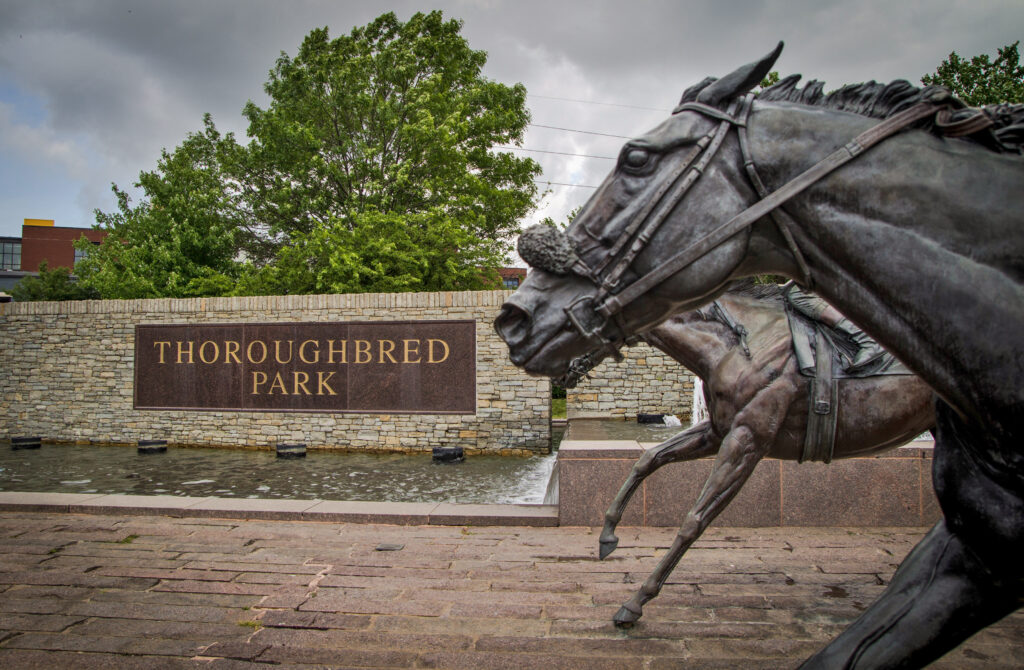
Dr. David Priest is a PBEC veterinarian who treats horses in Florida during the fall and winter and operates in his home state of Kentucky during the spring and summer. Dr. Priest primarily focuses on high performance racehorses with a special interest in respiratory function and surgery. As Coronavirus closures swept the nation and all factions of horse sport, Dr. Priest has been a prime witness to the impacts on the racing community from the bluegrass state.
By the time I returned to my family’s farm and residence in Kentucky on March 26, the commonwealth had already issued a stay at home order. The normally incredibly busy Keeneland Racecourse April Sale had been cancelled with no horses being allowed to stable at that track. I wasn’t surprised by that decision, given the circumstances, but it certainly had a profound impact on the horse industry and racing in Kentucky.
My normal daily care of horses at Keeneland during April, which is typically my busiest month, was non-existent. However, as a veterinarian and farm owner, I consider myself incredibly fortunate during this challenging time. I have still been treating horses daily, primarily those with more pressing medical needs, as well as horses at my family’s farm, which includes thoroughbred lay-ups, mares with foals, and dressage horses. All in all, I feel incredibly lucky.
Tracks here and across the country have been hit hard. Trainers whose livelihood depends on racing have just been doing what they can to keep horses going and giving them time turned out if possible. Its still a waiting game on when live spectator racing will return to Kentucky.
Churchill Downs began racing without spectators on May 16. Everyone that enters the track is required to have a negative COVID-19 test performed by Churchill Downs staff. They’ve set in place required temperature checks and face masks. I work mainly at Keeneland, which is a bit more relaxed in their protocols and is now allowing stabling and training for a small number of horses.
In central Kentucky, breeding thoroughbreds is king. The yearling sales, beginning in July and peaking in September, are the lifeblood of the breeding industry. There is tremendous uncertainty about these sales and what impacts this recession will cause. People typically come from all over the world for these sales where yearlings can be bought for $500,000 to well over $1 million dollars. There may be hundreds of thousands of dollars ties up in stud fees and expenses for a single yearling. Those profits are essential to supporting the entire industry.
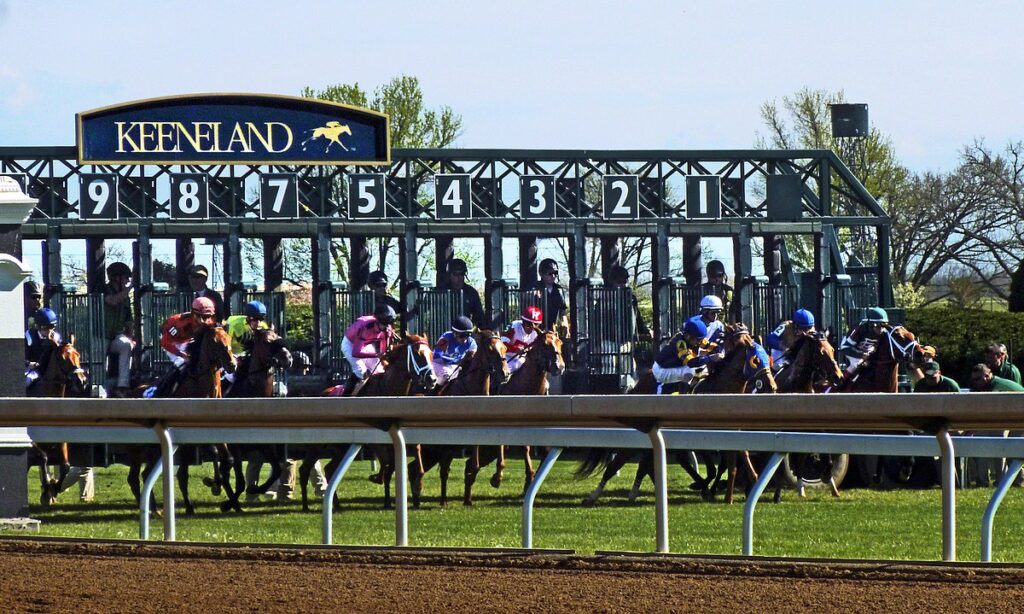
To say there is still a lot of uncertainty is an understatement. Personally, the real saving grace is that we can all focus on what we can control, which is taking care of our horses every day. That part hasn’t changed much at all, thank goodness for that. The rest of it is just going to have to sort itself out with time. Racing in some form will survive this. What exactly it will look like, no one can be entirely sure.
Stay in the loop on all Palm Beach Equine Clinic news and happenings by subscribing to our newsletter.
Taking a Chance on Madison
Palm Beach Equine Clinic helps one mini donkey survive a roller coaster of health concerns
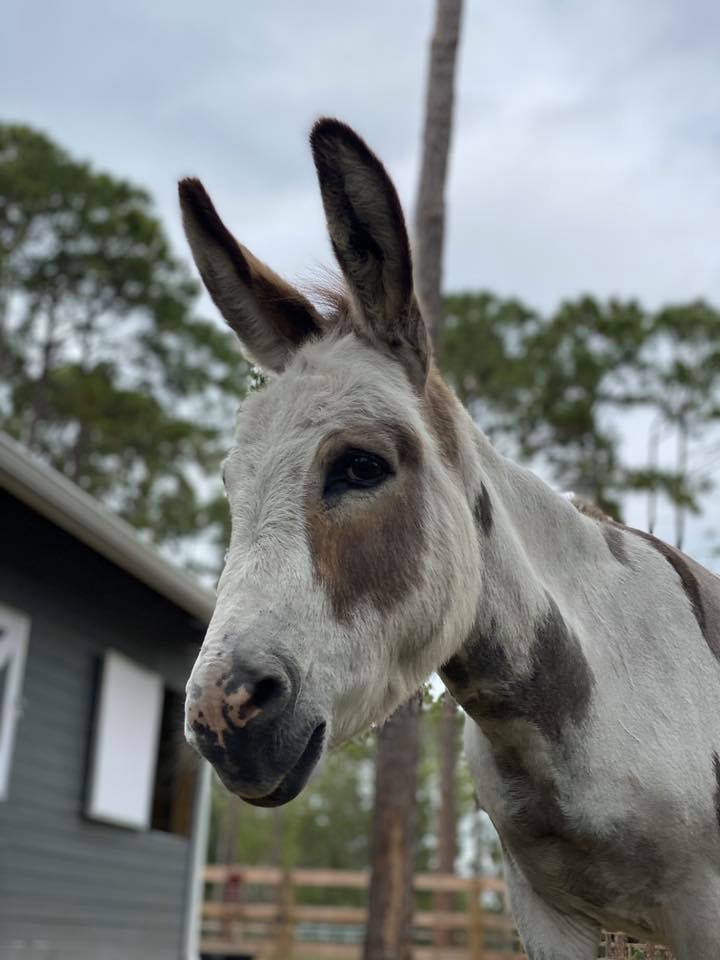
The popular veterinary adage, “if only they could just tell us how they feel,” never rang more true than in the case of an 11-year-old miniature donkey mare named Madison. Owned by Sariah Hopkins, “Madi” came to Palm Beach Equine Clinic by referral and was diagnosed with hyperlipemia, a common issue in miniature donkeys. Madi’s case, however, was never exactly how it seemed.
Hopkin’s describes Madi as the “center of attention.” Rescued from an animal hoarding situation by Safe Harbor Sanctuary in Nashville, TN, where Hopkins serves on the Board of Directors, Madi was officially adopted by Sariah and her husband Joel in 2015.
“She was one of 40 horses and donkeys being kept on four acres of land,” said Sariah, who relocated to Juno Beach, FL, with Madi in tow in 2018. “She has always had a super sweet, calm personality, but likes to kick up her heels. We’ve done behavioral health therapy work with foster children and she makes everyone who meets her fall in love. She is so engaging.”
After trading Tennessee for Florida, Madi didn’t adjust to her change in environment with ease. According to Sariah, a systematic decline in her health started while the mare tried to adjust to a new barn, environment, farrier, and life. “She was depressed,” said Sariah. “She wasn’t her bright-eyed self. She’s a donkey and she will eat anything so when she went off her grain and refused alfalfa, I called a local vet to pull fluids and run blood work.
“I reviewed the results with my vet in Tennessee who knows Madi and her history,” continued Sariah. “They were catastrophically bad, and she told me I needed to get Madi to a clinic immediately. I was referred to Palm Beach Equine Clinic by my friend Nataliya Boyko. Within minutes, I was on the phone with her vet, Dr. Bryan Dubynsky, and soon after we were on our way.”
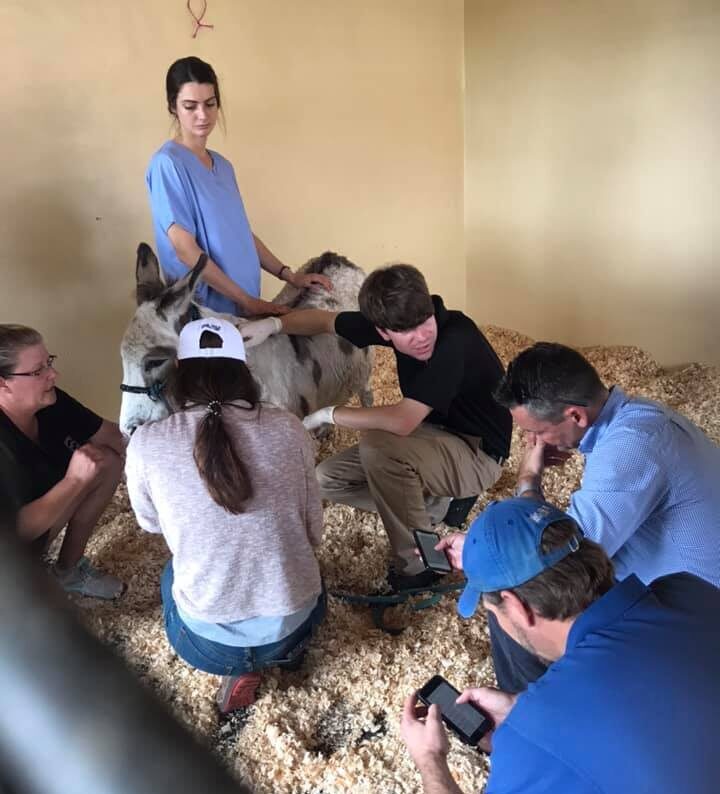
Once Madison arrived at Palm Beach Equine Clinic, she was treated primarily by Dr. Abby Berzas and overseen by Dr. Dubynsky. They diagnosed her with hyperlipemia, and she remained at the clinic for two weeks.

Hyperlipemia is a common metabolic disease of ponies, miniature horses, and donkeys. In affected patients, an increase in serum triglyceride concentrations (hypertriglyceridemia) puts them at risk for liver failure, renal failure, and multiorgan dysfunction that can ultimately lead to death.
Genetically, donkeys are designed to live in harsh environments with poor-quality forage. As a result, they tend to put on weight and gain excess fat reserves when living on relatively lush pasture. Unfortunately, when they stop eating for any reason – usually stress induced – hyperlipemia may develop due to a ‘negative energy balance’ where more energy is being used than is being taken in through eating. The essential organs of the body still require a food supply, so it uses the energy that has been stored as fat deposits. The result is that free fatty acids are circulated to the liver and converted to glucose for use by the body.

However, donkeys are not able to efficiently turn off this fat release. The blood soon fills up with excess fat in circulation, causing them to become very sick and uncomfortable. This circulating fat is measured in the blood as triglycerides.
Madison’s case presented as a severe spike in triglycerides, which can be reduced by introducing sugars into the system. The sugar causes the body to release insulin and drive the triglycerides down.
“She responded well the first day, but we didn’t see the improvement that we would have liked or that she needed,” said Dr. Berzas. “We started more aggressive treatments the following day with insulin therapy and antibiotics. The dextrose caused a physiological increase in insulin, but it wasn’t enough. As soon as she had insulin therapy her triglyceride levels started coming down. They decreased significantly and she started eating again.”
Madison remained on insulin therapy for a week and was evaluated hourly by Palm Beach Equine Clinic veterinarians to monitor the possibility of hypoglycemic shock. When Madison was able to eat regularly and maintain low triglyceride levels without any help, she was discharged.
“I had access to Madi daily, and we made the most of her time in the hospital with long hand walks, grazing, and relaxing in her stall,” said Sariah. “I got updates from the clinic every two to three hours when I wasn’t there, and without any more clinical signs, she appeared to be improving.
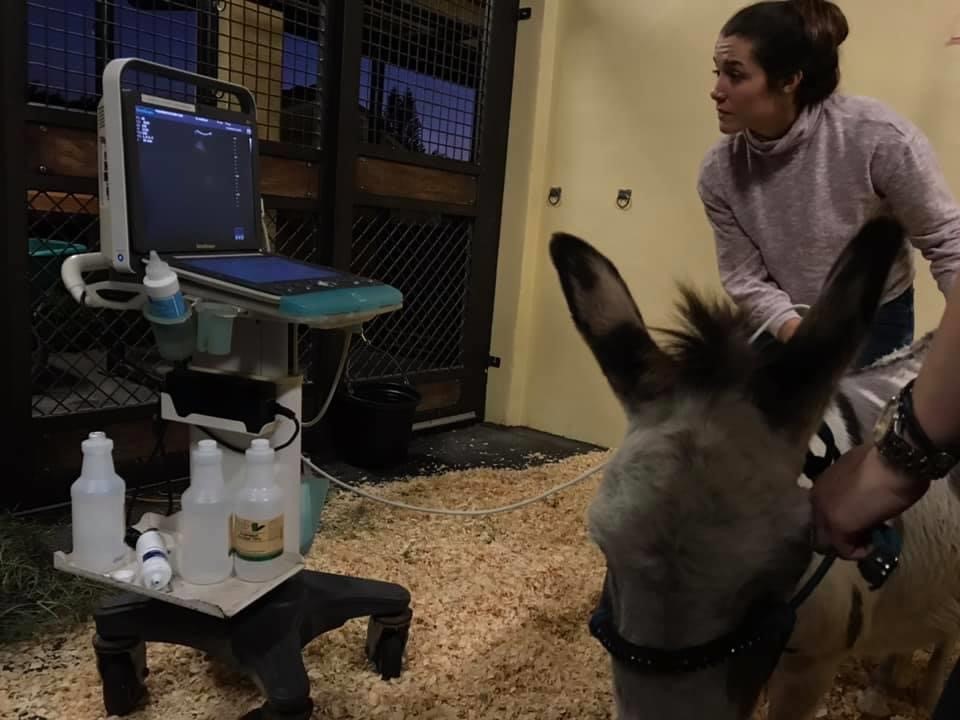
“But, when I got her home she still was not herself,” continued Sariah, who spent hours sitting in Madi’s stall with her. She moved home to Sariah and Joel’s private farm while they did all they could to eliminate the stress that had supposedly led to Madi’s condition. “She was good for 24 to 48 hours and then would slide backwards again. One afternoon, I was sitting in her stall and she had a coughing fit that I was able to video. I sent it to [Dr. Berzas] and she came out to the farm to check on Madi.”
Dr. Berzas performed a thoracic ultrasound and spotted comet tails in her lungs, leading to one thing: pneumonia.
“We were wracking our brains to figure out what the original stressor might have been that led to the hyperlipemia, but Madi did not display any signs of pneumonia at the clinic and did not cough once,” said Dr. Berzas. Then, there it was! Donkeys are stoic, tough animals, and sometimes they don’t give us traditional clinical signs.”
While hyperlipemia was the result, pneumonia was the cause.
“Cortisol, also known as the ‘stress hormone’ has a vast array of effects within the body, and it is one of the first triggers for the body to recruit energy from the its peripheral stores,” explained Palm Beach Equine Clinic Internal Medicine Specialist Dr. Peter Heidmann. “It minimizes discomfort and increases blood pressure and metabolic rate, basically saying, ‘Now is not the time to conserve energy for the future. I need energy now in order to survive.’ In Madison’s case, the infection prompted the body to need more than average energy – it needed extra fuel to fight the infection.”
The typical diagnostic procedure for pneumonia is a tracheal wash procedure, but after consulting with Dr. Heidmann, Dr. Berzas elected to try and mitigate any further stress on Madison by choosing a less invasive procedure. Instead, Dr. Berzas used a special stylette that allowed them to go through the nasal sinuses and cleanly aspirate back cellular fluid for analysis. This option is called a Bronchoalveolar Lavage (BAL), and is most typically used for diagnosing cell types in the lungs.
“After culturing her fluid aspirate, she went back on antibiotics and responded well,” said Dr. Berzas. “She also had nebulizer treatments that delivered antibiotics directly to the lungs, which is the best way to treat the infection.”
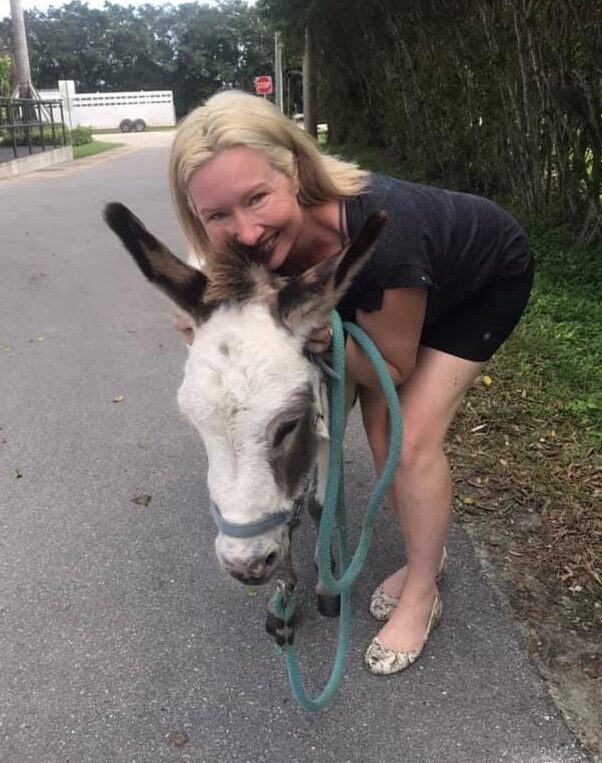
One month after the pneumonia diagnosis, Sariah was proud to report that Madi had made a full recovery. “When we brought her in that first day, we frankly were getting ready to say goodbye,” said Sariah. “We were devastated, and Dr. Dubynsky agreed to try and save Madi. Thank goodness he did!”
Once the pneumonia was cleared, Madi’s routine returned to normal and the hyperlipemia was no longer an issue. Today, Madi is happily running Sariah and Joel’s farm.
“Palm Beach Equine Clinic treats some of the top sport horses in the world, but I feel that Madi – a very special donkey – received the same treatment. Dr. Berzas was 100% available to me, and she championed Madi. I could not be more thankful to her and the entire team of veterinarians and staff who rallied around our Madi.”
Sariah Hopkins
“When we have a case that’s particularly challenging to diagnose,” Dr. Berzas remarked, “it just reminds us of how fortunate we are to be part of a team of specialists. At Palm Beach Equine Clinic, we are able to tap into the knowledge and experience of our fellow veterinarians from different specialties, and really deliver that value for the patient.”

Sariah chronicled Madi’s condition and recovery on her Facebook page, developing quite a fan base for the little donkey. Madi’s story is far from over, but now she’s telling it herself and can be followed on Facebook as @MadisonJoelleDonk.
The following information was requested by the Village of Wellington and posted at https://www.wellingtonfl.gov/767/Equestrian-Information
By Dr. Scott Swerdlin, President of Palm Beach Equine Clinic
For the health and safety of ourselves, our loved ones and the horse community, we must adhere to the recommendations from the Center for Disease Control and Prevention to help reduce the spread of COVID-19. We are fortunate that Wellington, specifically the Equestrian Overlay Zoning District, is not a high-density area. The Village offers picturesque idyllic weather beautiful horse farms and an abundance of expertise in all facets of the equine industry. Now is a unique opportunity for those who had been occupied by hectic schedules to take a step back, de-stress and even enjoy social distancing while saddling up.
Let’s make the most of this time while awaiting the demise of the novel coronavirus by continuing to ride and train our horses. Let’s try to keep a degree of normalcy in our daily routines at the farm and use this time wisely by improving our skills as horsemen. Let’s use this time to ensure that our horses and riders are healthy, fit and ready to resume competition when the appropriate time arrives.
Adjusting to Riding and Horse Care While Staying Healthy and Safe
Spending time riding and caring for your horse is a productive use of time. However, it is imperative that we proceed safely. Suggestions that I would make to help equestrians adhere to local, state and national health recommendations include:
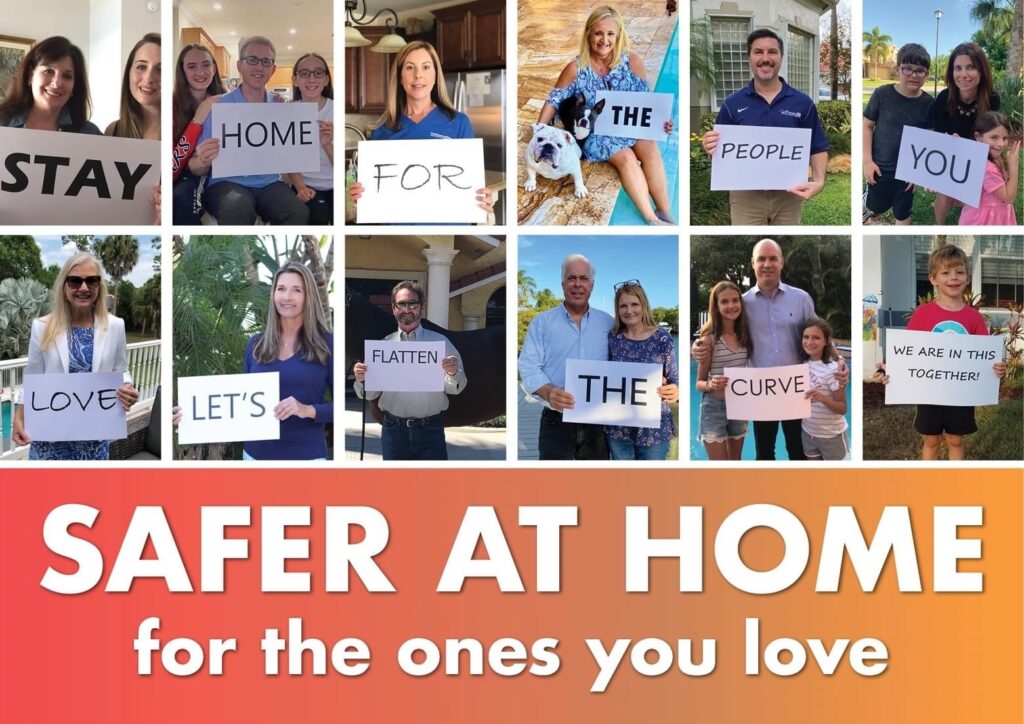
- Make Social Distancing mandatory at the barn. Everyone at the barn, including riders, parents, trainers and grooms, must practice Social Distancing by keeping six feet away from others. No exceptions! Do not permit individuals to congregate in the tack room or aisle ways. While in the saddle, please keep a safe distance away from fellow riders. Many facilities are limiting the number of people allowed at the barn or in the riding ring at any one time. Establishing scheduled riding times may help to streamline this while allowing everyone to participate with their horses. In addition, riders should severely limit the number of guests that they bring onto the property.
- Be vigilant with cleaning and sanitizing protocols by including surfaces and everyday objects often overlooked, such as whiteboard markers, doorknobs, stall latches, grooming brush handles, and crossties. Be mindful of disinfecting reins, saddles, and stirrups and washing brushes, polos, wraps and saddle pads. Barn staff should implement a routine of wiping down barn cleaning tools, such as pitch forks, wheelbarrows, etc.
- Make sanitizers, alcohol spray bottles or disinfecting wipes available throughout the barn. Washing your hands is one of the most effective ways to prevent the spread of this disease, so try to wash your hands upon arrival at the barn, before leaving, and insist that your staff wash their hands between handling different horses.
- Make suitable arrangements for reliable backup care in the event that you or your horse’s caretakers become sick. Organize detailed written instructions on feeding, medications and general care of your horse and provide these written instructions to the barn manager.
- Meet with your staff and grooms regularly to make sure everyone is being consistent in safety and cleaning protocols and has the most up to date information. Have them self-monitor for any signs of fever, coughing or sickness. If anyone experiences any signs of COVID-19, they should be required to remain in their homes and self-isolate to prevent further spread of the coronavirus. Work with your staff to ensure they are taken care of and compensated, if possible, during sick time. Likewise, if anyone suspects that they may have been exposed to COVID-19 or has travelled to areas where the virus is active within the past month, then they should not go to the barn for 14 days.
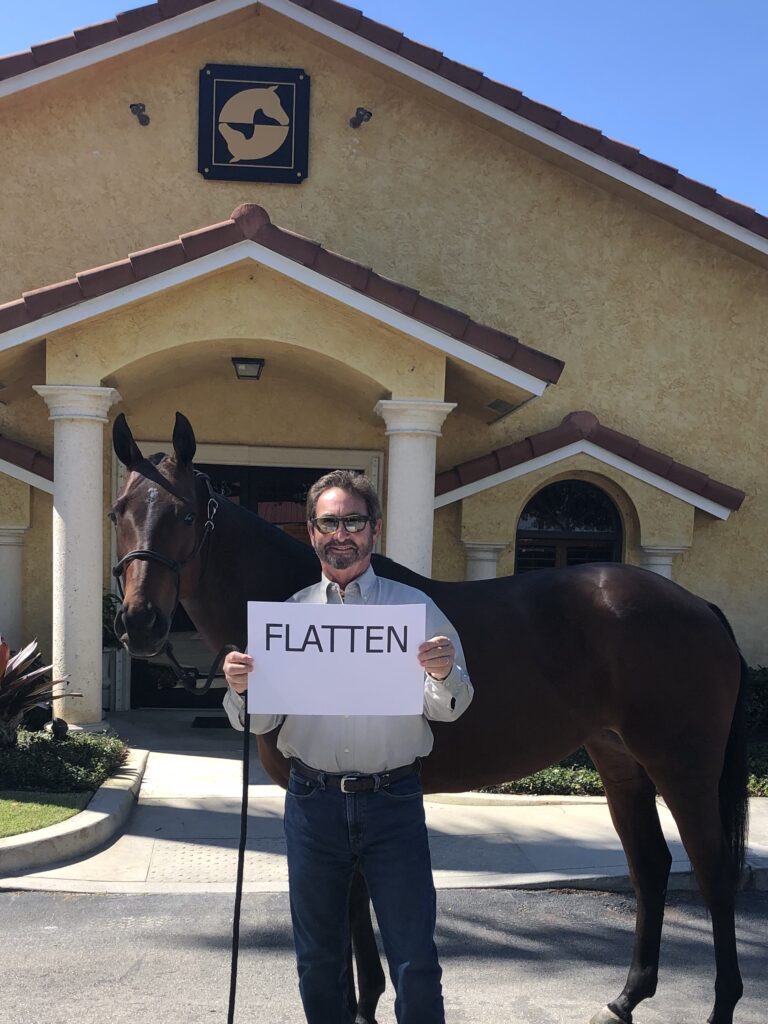
Our horses are blissfully oblivious of the pandemic, and we must remember that they still need daily attentive care. With the COVID-19 pandemic, we must adjust to help flatten the curve while remaining dedicated to the health, training and care and of all our horses. Should anyone have any questions or need assistance with caring for their horse’s health, please call Palm Beach Equine Clinic at 561-793-1599.
